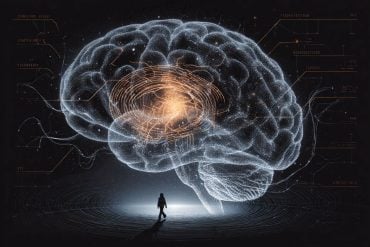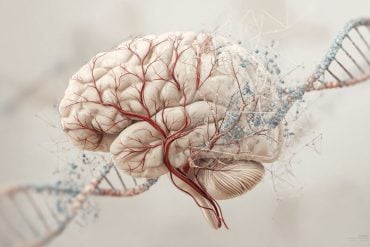Summary: In veterans who suffered a TBI, lack of sleep was associated with enlarged perivascular spaces and an increase in post-concussive symptoms.
Source: Oregon Health and Sciences University
Sound sleep plays a critical role in healing traumatic brain injury, a new study of military veterans suggests.
The study, published in the Journal of Neurotrauma, used a new technique involving magnetic resonance imaging developed at Oregon Health & Science University. Researchers used MRI to evaluate the enlargement of perivascular spaces that surround blood vessels in the brain. Enlargement of these spaces occurs in aging and is associated with the development of dementia.
Among veterans in the study, those who slept poorly had more evidence of these enlarged spaces and more post-concussive symptoms.
“This has huge implications for the armed forces as well as civilians,” said lead author Juan Piantino, M.D., MCR, assistant professor of pediatrics (neurology) in the OHSU School of Medicine and Doernbecher Children’s Hospital. “This study suggests sleep may play an important role in clearing waste from the brain after traumatic brain injury – and if you don’t sleep very well, you might not clean your brain as efficiently.”
Piantino, a physician-scientist with OHSU’s Papé Family Pediatric Research Institute, studies the effects of poor sleep on recovery after traumatic brain injuries.
The new study benefited from a method of analyzing MRIs developed by study co-author Daniel Schwartz and Erin Boespflug, Ph.D., under the direction of Lisa Silbert, M.D., M.C.R., professor of neurology in the OHSU School of Medicine. The technique measures changes in the brain’s perivascular spaces, which are part of the brain’s waste clearance system known as the glymphatic system.
“We were able to very precisely measure this structure and count the number, location and diameter of channels,” Piantino said.
Co-author Jeffrey Iliff, Ph.D., professor of psychiatry and behavioral sciences and of neurology at the University of Washington and a researcher at the VA Puget Sound Health Care System, has led scientific research into the glymphatic system and its role in neurodegenerative conditions such as Alzheimer’s disease. During sleep, this brain-wide network clears away metabolic proteins that would otherwise build up in the brain.

The study used data collected from a group of 56 veterans enrolled by co-authors Elaine Peskind, M.D., and Murray Raskind, M.D., at the Mental Illness Research, Education and Clinical Center at the VA Puget Sound between 2011 and 2019.
“Imagine your brain is generating all this waste and everything is working fine,” Piantino said. “Now you get a concussion. The brain generates much more waste that it has to remove, but the system becomes plugged.”
Piantino said the new study suggests the technique developed by Silbert could be useful for older adults.
“Longer term, we can start thinking about using this method to predict who is going to be at higher risk for cognitive problems including dementia,” he said.
The study is the latest in a growing body of research highlighting the importance of sleep in brain health.
Improving sleep is a modifiable habit that can be improved through a variety of methods, Piantino said, including better sleep hygiene habits such as reducing screen time before bed. Improving sleep is a focus of research of other OHSU scientists, including Piantino’s mentor, Miranda Lim, M.D., Ph.D., associate professor of neurology, medicine and behavioral neuroscience in the OHSU School of Medicine.
“This study puts sleep at the epicenter of recovery in traumatic brain injury,” Piantino said.
Funding: The study was supported by the National heart, Lung and Blood Institute of the National Institutes of Health, award K23HL150217-01; the U.S. Department of Veterans Affairs Rehabilitation Research and Development Service Merit Review grant B77421; and NIH award P30AG008017-18.
About this sleep and TBI research news
Source: Oregon Health and Sciences University
Contact: Erik Robinson – Oregon Health and Sciences University
Image: The image is in the public domain
Original Research: Closed access.
“Link between mild traumatic brain injury, poor sleep, and MRI-visible perivascular spaces in Veterans” by Juan Piantino et al. Journal of Neurotrauma
Abstract
Link between mild traumatic brain injury, poor sleep, and MRI-visible perivascular spaces in Veterans
Impaired clearance of perivascular waste in the brain may play a critical role in morbidity after mild traumatic brain injury (mTBI).
We aimed to determine the effect of mTBI on the burden of MRI-visible perivascular spaces (PVS) in a cohort of U.S. military veterans and whether sleep modulates this effect.
We also investigated the correlation between PVS burden and severity of persistent postconcussive symptoms.
Fifty-six Iraq/Afghanistan veterans received 3T MRI as part of a prospective cohort study on military blast mTBI. White matter PVS burden (i.e., number and volume) was calculated using an established automated segmentation algorithm. Multivariate regression was used to establish the association between mTBIs sustained in the military and PVS burden. Covariates included age, blood pressure, number of impact mTBIs outside the military, and blast exposures.
Correlation coefficients were calculated between PVS burden and severity of persistent postconcussive symptoms. There was a significant positive relationship between the number of mTBIs sustained in the military and both PVS number and volume (p=0.04).
A significant interaction was found between mTBI and poor sleep on PVS volume (p=0.04). A correlation was found between PVS number and volume, and severity of postconcussive symptoms (p=0.03). Further analysis revealed a moderate correlation between PVS number and volume, and balance problems (p<0.001). In Iraq/Afghanistan veterans, mTBI is associated with an increase in PVS burden. Furthermore, an interaction exists between mTBI and poor sleep on PVS burden.
Increased PVS burden, which may indicate waste clearance dysfunction, is associated with persistent postconcussive symptom severity.






